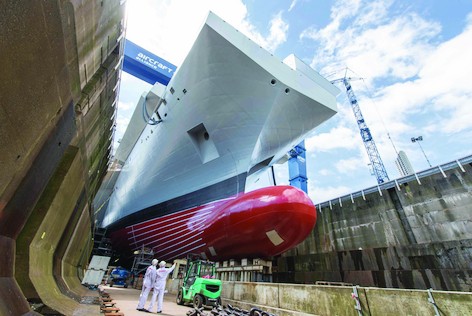All eyes are on Scotland this week where the Royal Navy’s new aircraft carrier is being readied for her naming ceremony on Friday.
The naming of HMS Queen Elizabeth comes just over six years since the ministry of defence announced the go-ahead for Elizabeth and HMS Prince of Wales.

Comprising 3,000 compartments over 17 decks, the 280m long HMS Queen Elizabeth will be the largest ship to enter service with the Royal Navy but will have a relatively small crew of 679. Capacity exists on board for 1,600 people, reflecting the multiple roles – such as humanitarian relief – that she may be called to fulfil during her anticipated 50 years of service.
In London, the Royal United Services Institute hosts its inaugural Sea Power conference in London. The two-day event is themed around ‘National Power Projection from the Sea – Challenges and Opportunities’ and will see senior naval officers and government officials convene with representatives from industry, academia discuss key issues in naval and maritime affairs for the coming year.
The conference will also launch RUSI’s Sea Power Research Programme, a three year initiative in conjunction with Greenwich University and King’s College London.
The naming of HMS Queen Elizabeth comes a time of relative buoyancy for the Royal Navy and the companies that help to keep it afloat, with contracts being awarded last week for work on Type 45 destroyers and the Type 26 Global Combat Ship.
BAE Systems announced a week ago that it has been awarded a £70m contract to manage the support, maintenance and upgrade of the Type 45 Destroyers at Portsmouth Naval Base and on all their operations in the UK and globally. The contract – commencing in July and running until the end of November 2016 - is expected to sustain 100 roles at BAE Systems in Portsmouth.
The Type 26 programme – which is likely to see the ministry of defence placing an order for 13 vessels – has moved forward also with BAE Systems awarding design contracts with six key suppliers.
The Design Development Agreements have been awarded to Babcock for the ship’s air weapons handling system; DCNS for work on the vessel’s propulsion shaftlines; GE Energy Power Conversion for the electric propulsion motor and drive System; Imtech for HVAC and low voltage electrical equipment; Raytheon to develop the integrated navigation and bridge systems; and finally Tyco Fire & Integrated Solutions for the ship’s fixed firefighting systems.
The Type 26 programme – designed to replace the Type 23 frigate – would take work at BAE’s Scotstoun site to at least the mid-2030s.
In the automotive sector SMMT is set to release its annual Sustainability Report, which will assess progress made on environmental, social and economic issues.
The organisation’s 2013 report – a look back to the sector’s performance in 2012 - found the sector in excellent health, with turnover increasing 2.8 per cent to £59.3bn, and a rise in production that saw 7.7 per cent more cars and CVs manufactured.
Further economic highlights from 2013 include a 9.2 per cent rise in automotive business R&D spend to £1.7bn, and a 1.7 per cent rise in car and CV registrations to 2.2 million.
Can automotive - or any form of materials-intensive manufacturing - make these gains whilst remaining environmentally benign?
The answer, according to SMMT’s 2013 report, is a resounding yes as the following figures demonstrate.
Environmental performance
- Energy use in automotive production decreased – down 7.6 per cent in total and 4.8 per cent per vehicle produced.
- Total water use in production increased 5.2 per cent in 2012, but fell 2.1 per cent per vehicle produced.
- Output of CO2 decreased 11.2 per cent in total and 3.2 per cent per vehicle produced.
- The amount of waste going to landfill from materials production dropped 21.1 per cent in total, 16.7 per cent per vehicle produced.
- Average new car emissions dropped 3.6 per cent in 2012 to 133.1 g/km CO2.
Source SMMT
The automotive sector has of course remained resilient since the downturn, and just recently it received a further boost in the form of a new £24m government fund, plus investment into the UK from two manufacturers.
The Tooling Funding Programme will help component manufacturers design, develop and manufacture new tooling where they would otherwise fail to acquire funds; whilst Nissan has invested £20m in its Sunderland production plant, a move that will create 50 extra jobs.

The UK also remains an attractive place to set up facilities, as witnessed by the decision of Detroit Electric to build its all-new model, the SP:01 (pictured above) in the UK.
The new 155mph electric vehicle will be manufactured in a new Detroit Electric production facility in Leamington Spa, which is set to employ 80 staff by early 2015.
Production is set to begin later in 2014, before models begin rolling off the production line destined for markets across Europe and Asia.





JLR teams with Allye Energy on portable battery storage
This illustrates the lengths required to operate electric vehicles in some circumstances. It is just as well few electric Range Rovers will go off...